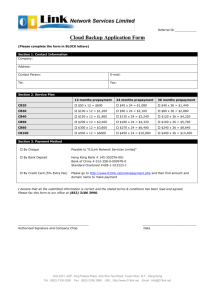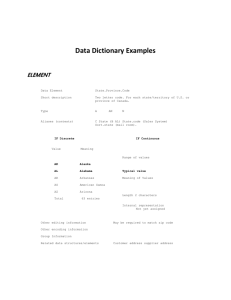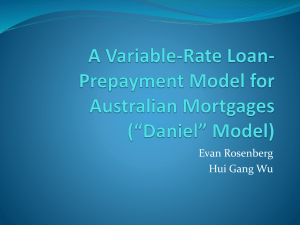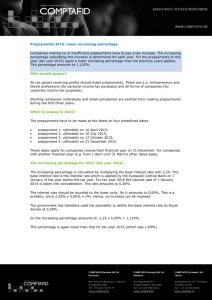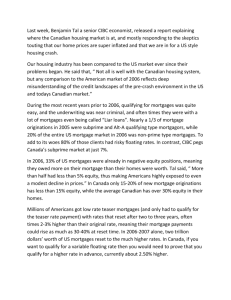Chapter 25
advertisement
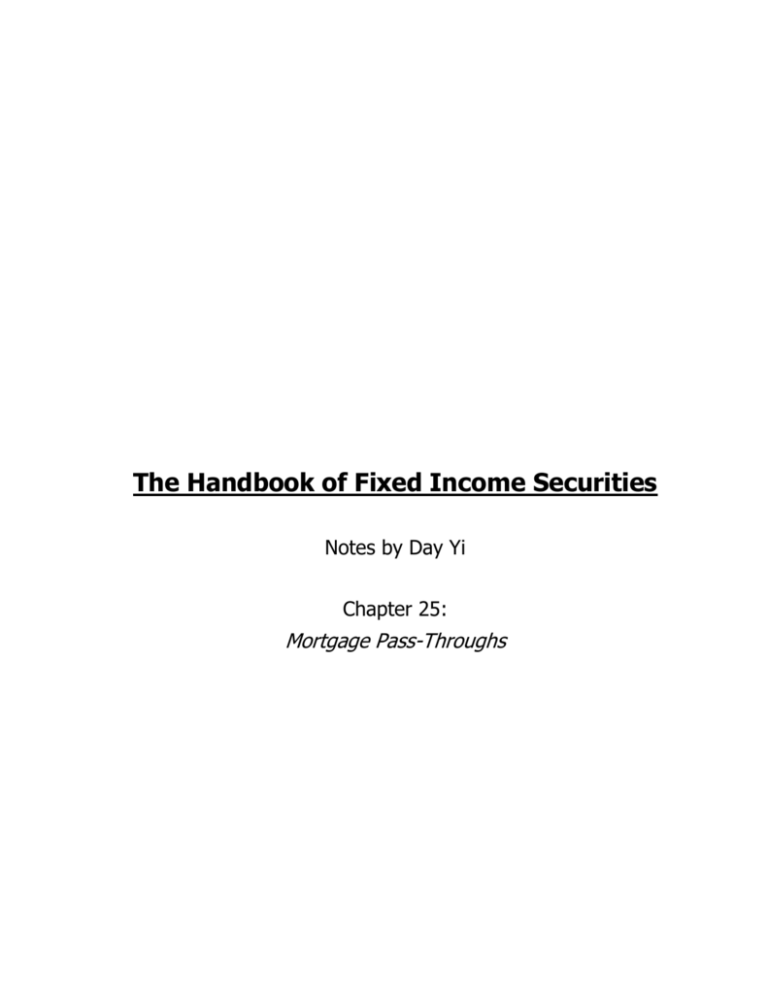
The Handbook of Fixed Income Securities Notes by Day Yi Chapter 25: Mortgage Pass-Throughs The Handbook of Fixed Income Securities 106755188 I. ORIGINS OF MBS PASS-THROUGHS A. The great majority of pass-throughs has been issued by three agencies that were created by Congress to 1. Increase liquidity in the secondary mortgage markets 2. Increase the supply of capital available for residential housing loans B. The Federal National Mortgage Association (FMNA or “Fannie Mae”) 1. The oldest of these agencies, was established by the federal government in 1938 to help solve some of the housing finance problems brought on by the Depression 2. FNMA’s original mandate allowed it to buy Federal Housing Administration (FHA) and Veterans Administration (VA) loans from lenders 3. In 1968, Congress divided the original FNMA into two organizations a. The current FNMA b. The Government National Mortgage Association (GNMA, or “Ginnie Mae”) 4. FNMA became a private corporation rechartered by Congress with a mandate to establish a secondary market for conventional mortgages, that is loans not FHA insured or VA guaranteed C. The Government National Mortgage Association (GNMA, or “Ginnie Mae”) 1. Remains a government agency within the Department of Housing and Urban Development (HUD) 2. Helps finance government-assisted housing programs D. The Federal Home Loan Mortgage Corporation (FHLMC, or “Freddie Mac”) 1. Initially (1970) was a government-chartered corporation owned by a. The 12 Federal Home Loan Banks b. The federally insured savings institutions, which in turned owned stock in the Federal Home Loan Banks 2. In 1989, as part of the Financial Institutions, Reform Recovery and Enforcement Act (FIRREA), FHMLC became a private corporation much like FNMA 3. Like FNMA, FHLMC seeks to enhance liquidity for residential mortgage investments, primarily by assisting in the development of secondary markets for conventional mortgages E. The creation of the pass-through by the government achieves two objectives of making investing in MBS more attractive 1. Credit risk is eliminated through the government’s implicit guaranty (explicit for GNMA’s) 2. The cash flow profile is made more predictable through a. Aggregation of a large number of loans b. Creation of a single fixed rate bond (vs. various rates on the underlying mortgages) F. Comparison of GNMA, FNMA and FHLMC Pass-Throughs 1. Guarantees a. GNMA pass-throughs are guaranteed directly by the U.S government as to timely payment of interest and principal 3/9/2016 1 The Handbook of Fixed Income Securities 106755188 b. FNMA and FHLMC pass-throughs carry agency guarantees only c. i. However, both agencies can borrow from the U.S. treasury ii. It is not likely that the U.S government would allow the agencies to default FNMA guarantees the timely payment of interest and principal on all its securities d. FHLMC guarantees the timely payment of interest and principal on its Gold program, originated in 1990, but on its 75-day program it guarantees the timely payment of interest and the ultimate (within one year) payment of principal e. From the investor’s point of view, because of the guarantees, a default is essentially equivalent to a prepayment 2. Payment Delay a. The delay is said to be i. 45 days from GNMAs and Gold FHLMCs ii. 55 days for FNMAs iii. 75 days for 75-day FHLMCs b. However, because interest for the month of August would be paid on September 1 if there were no delay, the actual delays are 14, 24, and 44 days, respectively 3. Pool Composition a. GNMA pools consist of VA- and FHA- insured mortgages that are assumable b. FNMA and FHLMC pools generally consist of conventional loans that are not assumable c. FNMA and FHLMC pools also tend to be much larger than GNMA pools and hence are less regionally concentrated 4. Liquidity a. FNMAs and FHLMCs are now generally as liquid as GNMAs b. Bid-ask spreads for the major coupons (currently in the 6.0 to 8.0% range) are generally about 1/8 of a point, which is similar to Treasuries and less than most corporates c. Liquidity for the major coupons is i. Comparable to that for Treasuries ii. Greater than that for most corporates d. The market for high-premium securities (with coupons of 10% or higher) has virtually disappeared because of the massive refinancings of high-coupon mortgages II. MODELING MBS CASH FLOWS A. MBS pass-through cash flows differ from typical bonds in two respects 1. Distributions are made monthly as opposed to semi-annually 2. The investor receives not only a monthly coupon, but also some amount of principal, the amount of which varies from month to month a. Predicting the amount and timing of this principal payment is the key to proper valuation of the MBS B. The minimum amount of information needed to project cash flows are 1. Balance 2 3/9/2016 The Handbook of Fixed Income Securities 106755188 2. Coupon rate 3. Remaining term 4. WAC C. The scheduled monthly principal amortization 1. Is calculated assuming each dollar of MBS is one loan having a. A rate equal to the WAC b. A term equal to the remaining term of the MBS 2. The scheduled principal payment is a function of the WAC, not the coupon, as the MBS amortizes along the schedule of the underlying mortgages 3. The coupon rate determines only the interest paid to the investor D. Prepayment and Cash Flow Behavior 1. Prepayment Models and Conventions a. Twelve-Year Prepaid Life i. Assumes no prepayments for the first 12 years of the pass-through life and then full prepayment at the end of the 12th year ii. Based on FHA data that showed that on average mortgages terminated in their 12 th year iii. Can often give misleading results b. Conditional Prepayment Rate (CPR) i. If one thinks of the pool as consisting of a large number of $1 mortgages, then the CPR for a period is the percentage of mortgages outstanding at the beginning of the period that terminate during that period ii. Usually expressed on an annualized basis, whereas the term single monthly mortality (SMM) or constant monthly prepayment (CMP) refers to monthly prepayment rates iii. The effective annual prepayment rate, or CPR, corresponding to a given monthly prepayment rate is almost, but not quite, equal to 12 times the monthly rate c. FHA Experience i. FHA experience projects the prepayment rate of a mortgage pool relative to the historical prepayment and default experience of FHA-insured, 30-year mortgage loans ii. FHA periodically publishes a table of 30 numbers that represents the annual survivorship rates of FHA-insured mortgages iii. A mortgage pool’s prepayment rates are expressed as a percentage of FHA experience iv. The major advantage of FHA experience over CPR is that it reflects the effect of age on prepayments and in particular the low prepayment level typical of newer mortgages v. Its major disadvantages are its complexity and the fact that periodic updates of the FHA data mean that the prepayment rates implied by a given percentage of FHA experience also change periodically d. Public Securities Association (PSA) Model 3/9/2016 3 The Handbook of Fixed Income Securities 106755188 i. The current industry standard ii. Developed to describe mortgage prepayment behavior by combining The information in the FHA survivorship schedules with The simplicity of the CPR method iii. The PSA benchmark (denoted 100% PSA) assumes A series of CPRs that begins at 0.2% in the first month Increases by 0.2% thereafter Levels off at 30 months after mortgage origination, when the CPR is 6% iv. Interpreting multiples of PSA is simpler than interpreting multiples of FHA v. To predict cash flows using the PSA prepayment model on a pass-through less than 30 months old requires an assumption of age to know the starting point for the PSA ramp e. Economic Prepayment Models i. In the most general case, an econometric prepayment model will project SMMs for each remaining month of the mortgage security ii. This vector of monthly prepayment rates will reflect seasonal and age variation in prepayments, as well as changing patterns of housing turnover and refinancing over time for a given pool of mortgages iii. For trading and sales purposes, using a vector of monthly prepayments is sometimes impractical iv. Using econometric models is often preferable to using recent prepayment levels as a means of choosing a projected CPR or PSA rate because changing economic factors may have made recent prepayment levels an unreliable indicator of future prepayments E. Price and Yield Behavior 1. Calculation of Yield-to-Maturity a. For an MBS there is a separate call option on each dollar of mortgage because in general a homeowner can prepay part or all of a mortgage at any time b. Because mortgages are self-amortizing, the amount redeemed if a homeowner “exercises a call” will depend on the original term, coupon, and age of the mortgage c. MBSs are now usually priced at a specified CPR or percentage of PSA d. The CPR or percentage of PSA to be used for a given MBS should be chosen using relevant mortgage characteristics and economic variables e. Pass-throughs have essentially the same credit quality and liquidity as agencies, so the pass-through spread over the agencies can be thought of as compensation for i. Prepayment uncertainty ii. The relative complexity of pass-throughs compared with agencies 2. Mortgage Yield and Bond-Equivalent Yield a. Mortgage pass-through cash flows typically are paid monthly 3. Price Behavior as Interest Rates Vary 4 3/9/2016 The Handbook of Fixed Income Securities 106755188 a. Discount coupon securities trading below par benefit from the early return of principal at par b. Premium securities trading above par experience a negative effect from early principal prepayment c. The extra coupon interest earned from the FNMAs and FHLMCs with higher coupons is partially canceled by faster expected prepayment levels d. Changes in the prevailing level of interest rates i. As interest rates increase, prepayments tend to slow down ii. As interest rates decrease, prepayments tend to increase 4. Prepayment Volatility a. In general, prepayment volatility is greatest for MBSs whose underlying mortgages have coupons between 100 and 300 basis points above current mortgage rates b. The effect of prepayments on yield will depend on the magnitude of the MBS price discount or premium c. Higher premium coupons experience less average life change than those priced close to par 5. Option-Adjusted Spread — Stochastic Valuation of Mortgage Securities a. The actual yield realized on the security has a high probability of being less than the yield projected on the basis of a single prepayment forecast b. Homeowners exercise their options to prepay their mortgages at the time least favorable to the investor c. The option-adjusted spread (OAS) model i. The cost of the homeowner’s prepayment option is calculated in terms of a basispoint penalty that must be subtracted from the expected yield spread on the security d. OAS will change less than a security’s yield spread as interest rates change i. In a flat yield curve, one can think of the OAS/yield spread relationship as OAS = Yield – Option cost ii. As rates fall, the option cost on a current coupon increases (it moves closer to being in the money) iii. Traders and investors adjust for this increased option cost by demanding wider spreads, which in turn keeps the OAS relatively unchanged III. RELATIVE VALUE A. Total Holding-Period Returns 1. From the investor’s point of view, yield-to-maturity can be an unsatisfactory measure of the likely return from the security for two important reasons a. The yield-to-maturity assumes that all the cash flows are reinvested at a rate equal to the yield b. It assumes that the security is held until maturity, thus ignoring the capital gain or loss from selling the security at the end of holding period 2. The total return (or the horizon or holding-period return) measures the actual return over a specified holding period and is composed of three elements 3/9/2016 5 The Handbook of Fixed Income Securities 106755188 a. The cash flows from the security during the holding period b. The reinvestment income from the cash flows from the time each cash flow is received to the end of the holding period for specified levels of reinvestment rates that prevailed during the holding period c. The gain or loss from selling the security at the end of the period 3. Assumptions Used in Calculating Total Returns a. Prepayment Rates b. Reinvestment Rates c. Selling Price at the Holding Period 4. Variations of Total Returns with Holding Period And Rate Changes a. The one-year returns depend on interest-rate changes to a greater degree than do the five-year returns i. The coupon and reinvestment income constitutes a much larger proportion of the total return over the five-year holding period, thus reducing the importance of the change in price of the security due to changes in interest rates ii. A larger proportion of the principal will pay down over the five-year period, because of both scheduled payment and prepayments This also reduces the importance of price changes, particularly in a declining interest rate environment when prepayments will be high b. The lackluster performance of both securities over the five-year period in the declining interest-rate scenarios is explained by the second point 6 i. The high prepayment levels result in a low remaining balance at the time of the sale ii. This reduces the benefits from price appreciation, which in any case has become compressed by the high prepayments 3/9/2016

